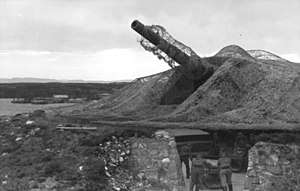28 cm SK L/45 gun
The 28 cm SK L/45[Note 1] was a German naval gun that was used in World War I and World War II. Originally a naval gun, it was adapted for land service after World War I.
| 28 cm SK L/45 | |
|---|---|
 Coast defense mounting of the SK L/45 gun at MAB 1./507 Husøya in Norway, during World War II | |
| Type | Naval gun Coast-defence gun |
| Place of origin | German Empire |
| Service history | |
| In service | 1910—45 |
| Used by | German Empire Nazi Germany Romania |
| Wars | World War I World War II |
| Production history | |
| Designer | Krupp |
| Designed | 1907—09 |
| Manufacturer | Krupp |
| Produced | 1909—13? |
| Specifications | |
| Mass | 39.8 metric tons (39 long tons; 44 short tons) |
| Length | 12.735 meters (41 ft 9 in) |
| Barrel length | 12.006 meters (39 ft 5 in) (bore length) |
| Shell | separate-loading, cased charge |
| Shell weight | 284–302 kilograms (626–666 lb) |
| Caliber | 283 millimeters (11 in) |
| Breech | horizontal sliding-wedge |
| Muzzle velocity | 855 to 875 m/s (2,810 to 2,870 ft/s) |
Description
The 28 cm SK L/45 gun weighed 39.8 metric tons (39.2 long tons; 43.9 short tons), had an overall length of 12.735 meters (41 ft 9.4 in) and its bore length was 12.006 meters (39.39 ft). Although designated as 28 cm (11 in), its actual caliber was 28.3 centimeters (11.1 in). It used the Krupp horizontal sliding-block breech design (or “wedge”, as it is sometimes referred to) rather than the interrupted screw commonly used in heavy guns of other nations. This required that the propellant charge be loaded in a metal, usually brass, case which provides obduration i.e. seals the breech to prevent escape of the expanding propellant gas.
History
Naval guns
Mounted on Nassau-class battleships and the battlecruiser SMS Von der Tann.
Coast defense guns
Three guns were mounted at Battery Goeben on Husøya island, near Trondheim, Norway and formed Naval Coast Artillery Battery (Marine Küstenartillerie Batterie) "Goeben", later 1st Battery, Naval Artillery Battalion (1./Marine Artillerie Batallion) 507 "Husöen".[1][2] Another three guns were mounted at Battery Tirpitz on the Romanian coast, south of Constanța, from April 1941[3] to August 1944, when the battery was destroyed by the retreating Germans.[4][5] The battery, like all Axis forces in Romania, was nominally under Romanian control, but operated by Kriegsmarine personnel,[6] and contributed to the defence of Constanța in 1941.[7][8]
See also
Footnotes
- Notes
- SK - Schnelladekanone (quick loading cannon); L - Länge in Kaliber (length in caliber)
- Citations
- "Artillergruppe Örlandet". www.nuav.net. Retrieved 19 August 2009.
- http://bunkersite.com/panzer/guns/28-45.php
- Steel and Ice: The U-boat Battle in the Arctic and Black Sea 1941-45, Chapter 5 - The Black Sea: War in the South 1942-43, 8th page
- Horia Macellariu - În plin uragan (in Romanian)
- Romania: Pages of History, Volume 4, p. 234
- Robert Kirchubel, Howard Gerrard, Operation Barbarossa 1941: Army Group South, p. 41
- Steel and Ice: The U-boat Battle in the Arctic and Black Sea 1941-45, Chapter 5 - The Black Sea: War in the South 1942-43, 8th page
- Jürgen Rohwer, Chronology of the War at Sea, 1939–1945: The Naval History of World War Two. Naval Institute Press, Annapolis, 2005, p. 83
References
- Campbell, John (2002). Naval Weapons of World War Two. London: Conway Maritime Press. ISBN 0-87021-459-4.
- Gander, Terry; Chamberlain, Peter (1979). Weapons of the Third Reich: An Encyclopedic Survey of All Small Arms, Artillery and Special Weapons of the German Land Forces 1939–1945. New York: Doubleday. ISBN 0-385-15090-3.
- Hogg, Ian V. (1997). German Artillery of World War Two (2nd corrected ed.). Mechanicsville, PA: Stackpole Books. ISBN 1-85367-480-X.
- Rolf, Rudi (1998). Der Atlantikwall: Bauten der deutschen Küstenbefestigungen 1940-1945. Osnabrück: Biblio. ISBN 3-7648-2469-7.
- Rolf, Rudi (2004). A Dictionary on Modern Fortification: An Illustrated Lexicon on European Fortification in the Period 1800-1945. Middleburg, Netherlands: PRAK.
- Schmalenbach, Paul (1983). "German Navy Large Bore Guns Operational Ashore During World War I". Warship International. XX (2): 123–153. ISSN 0043-0374.
External links
| Wikimedia Commons has media related to 28 cm SKL 45 Naval guns. |